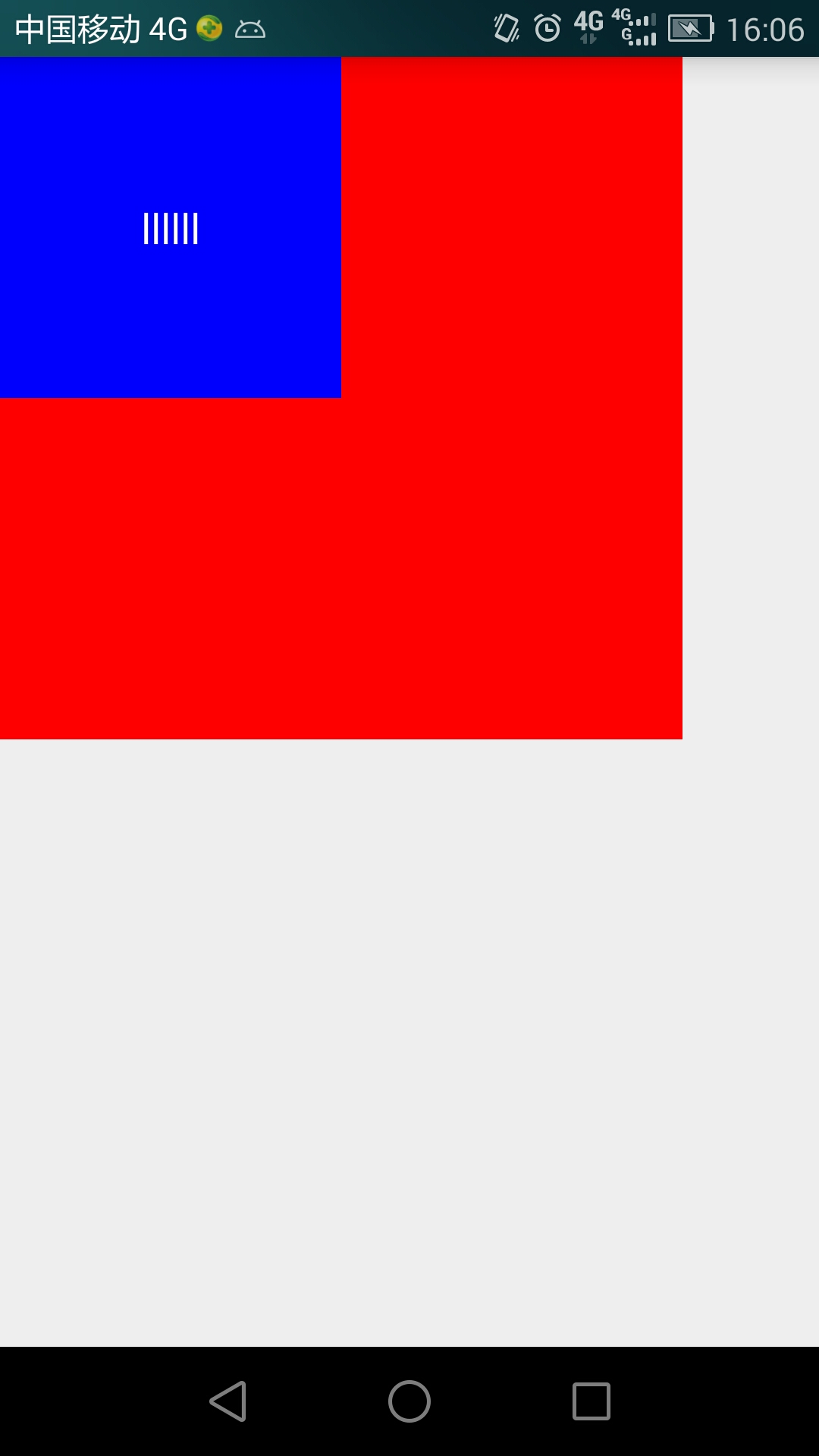一篇好文:http://blog.csdn.net/lmj623565791/article/details/39102591
先实现几个LinearLayout和Button 的继承类,加上日志:
MyLinearLayout:
package com.example.com.yzj.test;
import android.content.Context;
import android.util.AttributeSet;
import android.util.Log;
import android.view.MotionEvent;
import android.widget.LinearLayout;
public class MyLinearLayout extends LinearLayout {
String TAG = this.getClass().getSimpleName();
public MyLinearLayout(Context context, AttributeSet attrs) {
super(context, attrs);
}
public MyLinearLayout(Context context) {
super(context);
}
@Override
public boolean dispatchTouchEvent(MotionEvent ev) {
switch (ev.getAction()) {
case MotionEvent.ACTION_DOWN:
Log.e(TAG, "MyLinearLayout-----dispatchTouchEvent(ACTION_DOWN)");
break;
case MotionEvent.ACTION_MOVE:
Log.e(TAG, "MyLinearLayout-----dispatchTouchEvent(ACTION_MOVE)");
break;
case MotionEvent.ACTION_UP:
Log.e(TAG, "MyLinearLayout-----dispatchTouchEvent(ACTION_UP)");
break;
case MotionEvent.ACTION_CANCEL:
Log.e(TAG, "MyLinearLayout-----dispatchTouchEvent(ACTION_CANCEL)");
break;
}
return super.dispatchTouchEvent(ev);
}
@Override
public boolean onInterceptTouchEvent(MotionEvent ev) {
switch (ev.getAction()) {
case MotionEvent.ACTION_DOWN:
Log.e(TAG, "MyLinearLayout-----onInterceptTouchEvent(ACTION_DOWN)");
break;
case MotionEvent.ACTION_MOVE:
Log.e(TAG, "MyLinearLayout-----onInterceptTouchEvent(ACTION_MOVE)");
break;
case MotionEvent.ACTION_UP:
Log.e(TAG, "MyLinearLayout-----onInterceptTouchEvent(ACTION_UP)");
break;
case MotionEvent.ACTION_CANCEL:
Log.e(TAG,
"MyLinearLayout-----onInterceptTouchEvent(ACTION_CANCEL)");
break;
}
return super.onInterceptTouchEvent(ev);
}
@Override
public boolean onTouchEvent(MotionEvent ev) {
switch (ev.getAction()) {
case MotionEvent.ACTION_DOWN:
Log.e(TAG, "MyLinearLayout-----onTouchEvent(ACTION_DOWN)");
break;
case MotionEvent.ACTION_MOVE:
Log.e(TAG, "MyLinearLayout-----onTouchEvent(ACTION_MOVE)");
break;
case MotionEvent.ACTION_UP:
Log.e(TAG, "MyLinearLayout-----onTouchEvent(ACTION_UP)");
break;
case MotionEvent.ACTION_CANCEL:
Log.e(TAG, "MyLinearLayout-----onTouchEvent(ACTION_CANCEL)");
break;
}
return super.onTouchEvent(ev);
}
}
MyChildLinearLayout:
package com.example.com.yzj.test;
import android.content.Context;
import android.util.AttributeSet;
import android.util.Log;
import android.view.MotionEvent;
import android.widget.LinearLayout;
public class MyChildLinearLayout extends LinearLayout {
String TAG = this.getClass().getSimpleName();
public MyChildLinearLayout(Context context) {
super(context);
}
public MyChildLinearLayout(Context context, AttributeSet attrs) {
super(context, attrs);
}
@Override
public boolean dispatchTouchEvent(MotionEvent ev) {
switch (ev.getAction()) {
case MotionEvent.ACTION_DOWN:
Log.e(TAG, "ChildLinearLayout-----dispatchTouchEvent(ACTION_DOWN)");
break;
case MotionEvent.ACTION_MOVE:
Log.e(TAG, "ChildLinearLayout-----dispatchTouchEvent(ACTION_MOVE)");
break;
case MotionEvent.ACTION_UP:
Log.e(TAG, "ChildLinearLayout-----dispatchTouchEvent(ACTION_UP)");
break;
case MotionEvent.ACTION_CANCEL:
Log.e(TAG,
"ChildLinearLayout-----dispatchTouchEvent(ACTION_CANCEL)");
break;
}
return super.dispatchTouchEvent(ev);
}
@Override
public boolean onInterceptTouchEvent(MotionEvent ev) {
switch (ev.getAction()) {
case MotionEvent.ACTION_DOWN:
Log.e(TAG,
"ChildLinearLayout-----onInterceptTouchEvent(ACTION_DOWN)");
break;
case MotionEvent.ACTION_MOVE:
Log.e(TAG,
"ChildLinearLayout-----onInterceptTouchEvent(ACTION_MOVE)");
break;
case MotionEvent.ACTION_UP:
Log.e(TAG, "ChildLinearLayout-----onInterceptTouchEvent(ACTION_UP)");
break;
case MotionEvent.ACTION_CANCEL:
Log.e(TAG,
"ChildLinearLayout-----onInterceptTouchEvent(ACTION_CANCEL)");
break;
}
return super.onInterceptTouchEvent(ev);
}
@Override
public boolean onTouchEvent(MotionEvent ev) {
switch (ev.getAction()) {
case MotionEvent.ACTION_DOWN:
Log.e(TAG, "ChildLinearLayout-----onTouchEvent(ACTION_DOWN)");
break;
case MotionEvent.ACTION_MOVE:
Log.e(TAG, "ChildLinearLayout-----onTouchEvent(ACTION_MOVE)");
break;
case MotionEvent.ACTION_UP:
Log.e(TAG, "ChildLinearLayout-----onTouchEvent(ACTION_UP)");
break;
case MotionEvent.ACTION_CANCEL:
Log.e(TAG, "ChildLinearLayout-----onTouchEvent(ACTION_CANCEL)");
break;
}
return super.onTouchEvent(ev);
}
}
MyButton:
package com.example.com.yzj.test;
import android.content.Context;
import android.util.AttributeSet;
import android.util.Log;
import android.view.MotionEvent;
import android.widget.Button;
public class MyButton extends Button {
String TAG=this.getClass().getSimpleName();
public MyButton(Context context) {
super(context);
}
public MyButton(Context context, AttributeSet attrs) {
super(context, attrs);
}
@Override
public boolean dispatchTouchEvent(MotionEvent ev) {
switch(ev.getAction())
{
case MotionEvent.ACTION_DOWN:
Log.e(TAG, "MyButton-----dispatchTouchEvent(ACTION_DOWN)");
break;
case MotionEvent.ACTION_MOVE:
Log.e(TAG, "MyButton-----dispatchTouchEvent(ACTION_MOVE)");
break;
case MotionEvent.ACTION_UP:
Log.e(TAG, "MyButton-----dispatchTouchEvent(ACTION_UP)");
break;
case MotionEvent.ACTION_CANCEL:
Log.e(TAG, "MyButton-----dispatchTouchEvent(ACTION_CANCEL)");
break;
}
return super.dispatchTouchEvent(ev);
}
@Override
public boolean onTouchEvent(MotionEvent ev) {
switch(ev.getAction())
{
case MotionEvent.ACTION_DOWN:
Log.e(TAG, "MyButton-----onTouchEvent(ACTION_DOWN)");
break;
case MotionEvent.ACTION_MOVE:
Log.e(TAG, "MyButton-----onTouchEvent(ACTION_MOVE)");
break;
case MotionEvent.ACTION_UP:
Log.e(TAG, "MyButton-----onTouchEvent(ACTION_UP)");
break;
case MotionEvent.ACTION_CANCEL:
Log.e(TAG, "MyButton-----onTouchEvent(ACTION_CANCEL)");
break;
}
return super.onTouchEvent(ev);
}
}
MainActivity:
package com.example.com.yzj.test;
import android.app.Activity;
import android.os.Bundle;
import android.util.Log;
import android.view.Menu;
import android.view.MenuItem;
import android.view.MotionEvent;
import android.view.View;
import android.view.View.OnClickListener;
import android.view.View.OnTouchListener;
public class MainActivity extends Activity {
String TAG = this.getClass().getSimpleName();
MyLinearLayout llayout_super;
MyChildLinearLayout llayout_child;
MyButton btn_my;
@Override
protected void onCreate(Bundle savedInstanceState) {
super.onCreate(savedInstanceState);
setContentView(R.layout.activity_main);
initView();
}
private void initView() {
llayout_super = (MyLinearLayout) findViewById(R.id.llayout_super);
llayout_child = (MyChildLinearLayout) findViewById(R.id.llayout_child);
btn_my = (MyButton) findViewById(R.id.btn_my);
}
@Override
public boolean dispatchTouchEvent(MotionEvent ev) {
switch (ev.getAction()) {
case MotionEvent.ACTION_DOWN:
Log.e(TAG, "MainActivity-----dispatchTouchEvent(ACTION_DOWN)");
break;
case MotionEvent.ACTION_MOVE:
Log.e(TAG, "MainActivity-----dispatchTouchEvent(ACTION_MOVE)");
break;
case MotionEvent.ACTION_UP:
Log.e(TAG, "MainActivity-----dispatchTouchEvent(ACTION_UP)");
break;
case MotionEvent.ACTION_CANCEL:
Log.e(TAG, "MainActivity-----dispatchTouchEvent(ACTION_CANCEL)");
break;
}
return super.dispatchTouchEvent(ev);
}
@Override
public boolean onTouchEvent(MotionEvent ev) {
switch (ev.getAction()) {
case MotionEvent.ACTION_DOWN:
Log.e(TAG, "MainActivity-----onTouchEvent(ACTION_DOWN)");
break;
case MotionEvent.ACTION_MOVE:
Log.e(TAG, "MainActivity-----onTouchEvent(ACTION_MOVE)");
break;
case MotionEvent.ACTION_UP:
Log.e(TAG, "MainActivity-----onTouchEvent(ACTION_UP)");
break;
case MotionEvent.ACTION_CANCEL:
Log.e(TAG, "MainActivity-----onTouchEvent(ACTION_CANCEL)");
break;
}
return super.onTouchEvent(ev);
}
}
activity_main.xml
<RelativeLayout xmlns:android="http://schemas.android.com/apk/res/android"
xmlns:tools="http://schemas.android.com/tools"
android:layout_width="match_parent"
android:layout_height="match_parent"
tools:context="${relativePackage}.${activityClass}" >
<com.example.com.yzj.test.MyLinearLayout
android:id="@+id/llayout_super"
android:layout_width="match_parent"
android:layout_height="match_parent"
android:orientation="vertical" >
<com.example.com.yzj.test.MyChildLinearLayout
android:id="@+id/llayout_child"
android:layout_width="300dp"
android:layout_height="300dp"
android:background="#ff0000"
android:orientation="vertical" >
<com.example.com.yzj.test.MyButton
android:id="@+id/btn_my"
android:layout_width="150dp"
android:layout_height="150dp"
android:background="#0000ff"
android:text="llllll"
android:textColor="#ffffff" >
</com.example.com.yzj.test.MyButton>
</com.example.com.yzj.test.MyChildLinearLayout>
</com.example.com.yzj.test.MyLinearLayout>
</RelativeLayout>展示效果:
一、事件传递
1.按上面的代码正常点击蓝色按钮:
MainActivity—–dispatchTouchEvent(ACTION_DOWN)
MyLinearLayout—–dispatchTouchEvent(ACTION_DOWN)
MyLinearLayout—–onInterceptTouchEvent(ACTION_DOWN)
ChildLinearLayout—–dispatchTouchEvent(ACTION_DOWN)
ChildLinearLayout—–onInterceptTouchEvent(ACTION_DOWN)
MyButton—–dispatchTouchEvent(ACTION_DOWN)
MyButton—–onTouchEvent(ACTION_DOWN)
MainActivity—–dispatchTouchEvent(ACTION_UP)
MyLinearLayout—–dispatchTouchEvent(ACTION_UP)
MyLinearLayout—–onInterceptTouchEvent(ACTION_UP)
ChildLinearLayout—–dispatchTouchEvent(ACTION_UP)
ChildLinearLayout—–onInterceptTouchEvent(ACTION_UP)
MyButton—–dispatchTouchEvent(ACTION_UP)
MyButton—–onTouchEvent(ACTION_UP)
MyButton因为是可以clickable的,所以MyButton的onTouchEvent会返回true,消费掉该次事件
2.将activity_main.xml中的MyButton 的android:clickable属性设置为false,默认情况下Button是true的,点击蓝色按钮
MainActivity—–dispatchTouchEvent(ACTION_DOWN)
MyLinearLayout—–dispatchTouchEvent(ACTION_DOWN)
MyLinearLayout—–onInterceptTouchEvent(ACTION_DOWN)
ChildLinearLayout—–dispatchTouchEvent(ACTION_DOWN)
ChildLinearLayout—–onInterceptTouchEvent(ACTION_DOWN)
MyButton—–dispatchTouchEvent(ACTION_DOWN)
MyButton—–onTouchEvent(ACTION_DOWN)
ChildLinearLayout—–onTouchEvent(ACTION_DOWN)
MyLinearLayout—–onTouchEvent(ACTION_DOWN)
MainActivity—–onTouchEvent(ACTION_DOWN)
MainActivity—–dispatchTouchEvent(ACTION_UP)
MainActivity—–onTouchEvent(ACTION_UP)
因为MyButton的clickable为false,所以他的onTouchEvent没有消费事件,返回了false,所以依次往上冒泡,直到MainActivity,最终到Activity的onTouchEvent终止,所以在后面的up事件中,将不会再传递到子类再冒泡,而是直接由MainActivity处理up事件
3.在2的基础上将MyChildLinearLayout的onTouchEvent return true或者将activity_main.xml中child的android:clickable 属性设置为true,则点击蓝色按钮
MainActivity—–dispatchTouchEvent(ACTION_DOWN)
MyLinearLayout—–dispatchTouchEvent(ACTION_DOWN)
MyLinearLayout—–onInterceptTouchEvent(ACTION_DOWN)
ChildLinearLayout—–dispatchTouchEvent(ACTION_DOWN)
ChildLinearLayout—–onInterceptTouchEvent(ACTION_DOWN)
MyButton—–dispatchTouchEvent(ACTION_DOWN)
MyButton—–onTouchEvent(ACTION_DOWN)
ChildLinearLayout—–onTouchEvent(ACTION_DOWN)
MainActivity—–dispatchTouchEvent(ACTION_UP)
MyLinearLayout—–dispatchTouchEvent(ACTION_UP)
MyLinearLayout—–onInterceptTouchEvent(ACTION_UP)
ChildLinearLayout—–dispatchTouchEvent(ACTION_UP)
ChildLinearLayout—–onTouchEvent(ACTION_UP)
从这里可以看出child的onTouchEvent消费了事件,同样在child的时候消费了down事件,在up的时候就从父到子child,不会再传到button
二、事件拦截
1.在原来最初的代码上将MyChildLinearLayout的onInterceptTouchEvent修改为
@Override
public boolean onInterceptTouchEvent(MotionEvent ev) {
switch (ev.getAction()) {
case MotionEvent.ACTION_DOWN:
Log.e(TAG,
"ChildLinearLayout-----onInterceptTouchEvent(ACTION_DOWN)");
//break;
return true;
case MotionEvent.ACTION_MOVE:
Log.e(TAG,
"ChildLinearLayout-----onInterceptTouchEvent(ACTION_MOVE)");
break;
case MotionEvent.ACTION_UP:
Log.e(TAG, "ChildLinearLayout-----onInterceptTouchEvent(ACTION_UP)");
break;
case MotionEvent.ACTION_CANCEL:
Log.e(TAG,
"ChildLinearLayout-----onInterceptTouchEvent(ACTION_CANCEL)");
break;
}
return super.onInterceptTouchEvent(ev);
}即拦截Down事件
则点击蓝色按钮
MainActivity—–dispatchTouchEvent(ACTION_DOWN)
MyLinearLayout—–dispatchTouchEvent(ACTION_DOWN)
MyLinearLayout—–onInterceptTouchEvent(ACTION_DOWN)
ChildLinearLayout—–dispatchTouchEvent(ACTION_DOWN)
ChildLinearLayout—–onInterceptTouchEvent(ACTION_DOWN)
ChildLinearLayout—–onTouchEvent(ACTION_DOWN)
MyLinearLayout—–onTouchEvent(ACTION_DOWN)
MainActivity—–onTouchEvent(ACTION_DOWN)
MainActivity—–dispatchTouchEvent(ACTION_MOVE)
MainActivity—–onTouchEvent(ACTION_MOVE)
MainActivity—–dispatchTouchEvent(ACTION_MOVE)
MainActivity—–onTouchEvent(ACTION_MOVE)
MainActivity—–dispatchTouchEvent(ACTION_MOVE)
MainActivity—–onTouchEvent(ACTION_MOVE)
MainActivity—–dispatchTouchEvent(ACTION_MOVE)
MainActivity—–onTouchEvent(ACTION_MOVE)
MainActivity—–dispatchTouchEvent(ACTION_MOVE)
MainActivity—–onTouchEvent(ACTION_MOVE)
MainActivity—–dispatchTouchEvent(ACTION_MOVE)
MainActivity—–onTouchEvent(ACTION_MOVE)
MainActivity—–dispatchTouchEvent(ACTION_MOVE)
MainActivity—–onTouchEvent(ACTION_MOVE)
MainActivity—–dispatchTouchEvent(ACTION_MOVE)
MainActivity—–onTouchEvent(ACTION_MOVE)
MainActivity—–dispatchTouchEvent(ACTION_MOVE)
MainActivity—–onTouchEvent(ACTION_MOVE)
MainActivity—–dispatchTouchEvent(ACTION_MOVE)
MainActivity—–onTouchEvent(ACTION_MOVE)
MainActivity—–dispatchTouchEvent(ACTION_MOVE)
MainActivity—–onTouchEvent(ACTION_MOVE)
MainActivity—–dispatchTouchEvent(ACTION_MOVE)
MainActivity—–onTouchEvent(ACTION_MOVE)
MainActivity—–dispatchTouchEvent(ACTION_MOVE)
MainActivity—–onTouchEvent(ACTION_MOVE)
MainActivity—–dispatchTouchEvent(ACTION_UP)
MainActivity—–onTouchEvent(ACTION_UP)
特意加了MOVE事件,可见button没有收到任何事件,全部被child拦截,至于后面的move,up就跟前面事件传递一样,因为child的onTouchEvent返回false,最终指向到了activity为止,则后面的move和up都在派发后直接给了activity来处理
这种情况下,down就被父拦击,则无论如何button都不会有事件了,无论用什么方法
2.在原来最初的代码上将MyChildLinearLayout的onInterceptTouchEvent修改为
@Override
public boolean onInterceptTouchEvent(MotionEvent ev) {
switch (ev.getAction()) {
case MotionEvent.ACTION_DOWN:
Log.e(TAG,
"ChildLinearLayout-----onInterceptTouchEvent(ACTION_DOWN)");
break;
case MotionEvent.ACTION_MOVE:
Log.e(TAG,
"ChildLinearLayout-----onInterceptTouchEvent(ACTION_MOVE)");
//break;
return true;
case MotionEvent.ACTION_UP:
Log.e(TAG, "ChildLinearLayout-----onInterceptTouchEvent(ACTION_UP)");
break;
case MotionEvent.ACTION_CANCEL:
Log.e(TAG,
"ChildLinearLayout-----onInterceptTouchEvent(ACTION_CANCEL)");
break;
}
return super.onInterceptTouchEvent(ev);
}即拦截move事件
MainActivity—–dispatchTouchEvent(ACTION_DOWN)
MyLinearLayout—–dispatchTouchEvent(ACTION_DOWN)
MyLinearLayout—–onInterceptTouchEvent(ACTION_DOWN)
ChildLinearLayout—–dispatchTouchEvent(ACTION_DOWN)
ChildLinearLayout—–onInterceptTouchEvent(ACTION_DOWN)
MyButton—–dispatchTouchEvent(ACTION_DOWN)
MyButton—–onTouchEvent(ACTION_DOWN)
MainActivity—–dispatchTouchEvent(ACTION_MOVE)
MyLinearLayout—–dispatchTouchEvent(ACTION_MOVE)
MyLinearLayout—–onInterceptTouchEvent(ACTION_MOVE)
ChildLinearLayout—–dispatchTouchEvent(ACTION_MOVE)
ChildLinearLayout—–onInterceptTouchEvent(ACTION_MOVE)
MyButton—–dispatchTouchEvent(ACTION_CANCEL)
MyButton—–onTouchEvent(ACTION_CANCEL)
MainActivity—–dispatchTouchEvent(ACTION_MOVE)
MyLinearLayout—–dispatchTouchEvent(ACTION_MOVE)
MyLinearLayout—–onInterceptTouchEvent(ACTION_MOVE)
ChildLinearLayout—–dispatchTouchEvent(ACTION_MOVE)
ChildLinearLayout—–onTouchEvent(ACTION_MOVE)
MainActivity—–onTouchEvent(ACTION_MOVE)
MainActivity—–dispatchTouchEvent(ACTION_MOVE)
MyLinearLayout—–dispatchTouchEvent(ACTION_MOVE)
MyLinearLayout—–onInterceptTouchEvent(ACTION_MOVE)
ChildLinearLayout—–dispatchTouchEvent(ACTION_MOVE)
ChildLinearLayout—–onTouchEvent(ACTION_MOVE)
MainActivity—–onTouchEvent(ACTION_MOVE)
MainActivity—–dispatchTouchEvent(ACTION_UP)
MyLinearLayout—–dispatchTouchEvent(ACTION_UP)
MyLinearLayout—–onInterceptTouchEvent(ACTION_UP)
ChildLinearLayout—–dispatchTouchEvent(ACTION_UP)
ChildLinearLayout—–onTouchEvent(ACTION_UP)
MainActivity—–onTouchEvent(ACTION_UP)
在第一次移动的时候child中的move后,还会继续调用button的dispatch和ontouchevent,但是他们去执行的是action_cancel,猜想应该是前面有了down事件,现在要将其取消掉,在后面的move和up中不会再去执行,但是有个不解,为什么这样拦截后child的上层linearlayout中的ontouchevent没有执行呢? 猜想这就是因为move和up在viewgroup不能回传,直接到了activity的原因
至于这种情况下,如果button不让child拦截,是有办法的,因为他第一次down已经进去了,我们可以在button的down中做些设置,禁止他的父控件拦截事件
3.在2的基础上,修改MyButton代码:
@Override
public boolean onTouchEvent(MotionEvent ev) {
switch(ev.getAction())
{
case MotionEvent.ACTION_DOWN:
Log.e(TAG, "MyButton-----onTouchEvent(ACTION_DOWN)");
getParent().requestDisallowInterceptTouchEvent(true);
break;
case MotionEvent.ACTION_MOVE:
Log.e(TAG, "MyButton-----onTouchEvent(ACTION_MOVE)");
break;
case MotionEvent.ACTION_UP:
Log.e(TAG, "MyButton-----onTouchEvent(ACTION_UP)");
getParent().requestDisallowInterceptTouchEvent(false);
break;
case MotionEvent.ACTION_CANCEL:
Log.e(TAG, "MyButton-----onTouchEvent(ACTION_CANCEL)");
getParent().requestDisallowInterceptTouchEvent(false);
break;
}
return super.onTouchEvent(ev);
}事件顺序:
MainActivity—–dispatchTouchEvent(ACTION_DOWN)
MyLinearLayout—–dispatchTouchEvent(ACTION_DOWN)
MyLinearLayout—–onInterceptTouchEvent(ACTION_DOWN)
ChildLinearLayout—–dispatchTouchEvent(ACTION_DOWN)
ChildLinearLayout—–onInterceptTouchEvent(ACTION_DOWN)
MyButton—–dispatchTouchEvent(ACTION_DOWN)
MyButton—–onTouchEvent(ACTION_DOWN)
MainActivity—–dispatchTouchEvent(ACTION_MOVE)
MyLinearLayout—–dispatchTouchEvent(ACTION_MOVE)
ChildLinearLayout—–dispatchTouchEvent(ACTION_MOVE)
MyButton—–dispatchTouchEvent(ACTION_MOVE)
MyButton—–onTouchEvent(ACTION_MOVE)
MainActivity—–dispatchTouchEvent(ACTION_MOVE)
MyLinearLayout—–dispatchTouchEvent(ACTION_MOVE)
ChildLinearLayout—–dispatchTouchEvent(ACTION_MOVE)
MyButton—–dispatchTouchEvent(ACTION_MOVE)
MyButton—–onTouchEvent(ACTION_MOVE)
MainActivity—–dispatchTouchEvent(ACTION_MOVE)
MyLinearLayout—–dispatchTouchEvent(ACTION_MOVE)
ChildLinearLayout—–dispatchTouchEvent(ACTION_MOVE)
MyButton—–dispatchTouchEvent(ACTION_MOVE)
MyButton—–onTouchEvent(ACTION_MOVE)
MainActivity—–dispatchTouchEvent(ACTION_MOVE)
MyLinearLayout—–dispatchTouchEvent(ACTION_MOVE)
ChildLinearLayout—–dispatchTouchEvent(ACTION_MOVE)
MyButton—–dispatchTouchEvent(ACTION_MOVE)
MyButton—–onTouchEvent(ACTION_MOVE)
MainActivity—–dispatchTouchEvent(ACTION_UP)
MyLinearLayout—–dispatchTouchEvent(ACTION_UP)
ChildLinearLayout—–dispatchTouchEvent(ACTION_UP)
MyButton—–dispatchTouchEvent(ACTION_UP)
MyButton—–onTouchEvent(ACTION_UP)
可以看出child没能拦截button的事件,因为onInterceptTouchEvent根本没有执行,原因就是getParent().requestDisallowInterceptTouchEvent(true);禁止了父控件中的拦截,并且这个函数也是递归的,一致余从child到child的父控件的拦截函数都没有执行
这里面还有些疑问,还需要去探究。。。























 3070
3070

 被折叠的 条评论
为什么被折叠?
被折叠的 条评论
为什么被折叠?








